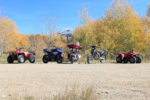Navigating the backcountry during the winter snowy season with ATVs and OHVs requires a thoughtful approach to safety. To ensure a secure and enjoyable experience, consider these crucial tips that encompass vehicle preparation, terrain knowledge, proper attire, safety gear, group travel, trail adherence, weather monitoring, emergency preparedness, environmental respect, and the importance of training and awareness.

Vehicle Preparation
Ensure your ATV or UTV is winter-ready. Equip it with appropriate tires or tracks for snow travel. Check the engine, brakes, and lights to ensure they function well in colder conditions.
Know the Terrain
Familiarize yourself with the backcountry terrain. Understand the trails, potential hazards, and any changes due to snow cover. Maps, GPS devices, and local guidance can be invaluable.

Dress for the Occasion
Dress in layers and ensure you have appropriate winter gear. Temperatures can drop rapidly in backcountry areas, so it’s crucial to be prepared for changing weather conditions.

Safety Gear
Always wear a helmet and other protective gear. Bring along a shovel, in case you get stuck. Additionally, consider carrying avalanche safety equipment if venturing into avalanche-prone areas.

Travel in Groups
Avoid solo trips, especially in remote snow-covered regions. Traveling in a group ensures there’s assistance available if needed and enhances safety in case of emergencies.

Stay on Designated Trails
Roaming off marked trails can be dangerous, especially in snow-covered areas where hidden hazards like tree wells or avalanche-prone zones might exist. Read more about Colorado Trails at Stay the Trail.

Check Weather Conditions
Keep an eye on weather forecasts before and during your trip. Snowstorms or blizzards can drastically alter conditions and pose severe risks.
Carry Emergency Supplies
Pack essentials like a first aid kit, communication devices (satellite phones or radios), food, water, and a tool kit for any unexpected situations. Bring your phone, but remember that you may not have cell service on many off-road adventures. Extra ways to communicate can help in an emergency.

Respect Nature and Wildlife
Be mindful of wildlife and the natural environment. Avoid disturbing animals and respect local guidelines and regulations. .Exercise awareness and consideration towards wildlife and the surrounding natural environment. Refrain from disturbing animals and adhere to local guidelines and regulations. While baby animals may be adorable, it is especially important to maintain a safe distance and avoid interaction, particularly with mothers who are exceptionally protective.
Training and Awareness
Prioritize proper training and awareness of winter-specific challenges when operating ATVs/OHVs in snow-covered backcountry areas. This could include specific handling techniques for snow and ice.

These tips can significantly enhance safety while enjoying snow-covered backcountry areas with ATVs and OHVs. Always prioritize caution, preparedness, and adherence to local regulations to ensure backcountry safety in winter.



